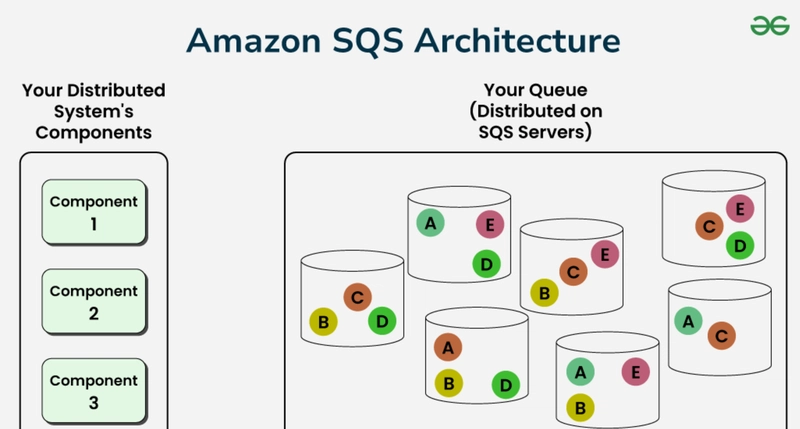In today's cloud-native world, decoupling applications is key to building scalable, resilient systems. That's where AWS SQS comes in — a fully managed message queuing service that enables asynchronous communication between distributed systems.
Whether you're building microservices or event-driven applications, Amazon Simple Queue Service (SQS) offers a reliable, secure, and scalable solution for managing message queues without managing your own queuing infrastructure.
📦 What is AWS SQS?
Amazon SQS is a distributed message queuing service designed to facilitate communication between software components without requiring them to be tightly coupled.
Think of SQS as a post office: senders post letters (messages), and recipients collect them at their convenience.
🧩 Key Features of AWS SQS
| Feature | Description |
|---|---|
| Fully Managed | No need to provision or manage servers. |
| Scalable | Automatically scales to handle any message volume. |
| Durable | Stores messages across multiple AZs (Availability Zones). |
| Secure | Offers end-to-end encryption, access control with IAM. |
| Flexible Delivery | Supports standard and FIFO queues. |
| Dead Letter Queues | Handles message processing failures. |
🛠️ Types of Queues in SQS
1. Standard Queues
- High throughput
- At-least-once delivery (possible duplicates)
- Best-effort ordering
2. FIFO (First-In-First-Out) Queues
- Exactly-once processing
- Strict message ordering
- Ideal for financial or transactional systems
🔄 How AWS SQS Works
- Producer sends a message to the queue.
- SQS holds the message securely.
- Consumer retrieves the message for processing.
- Once processed, the message is deleted.
Simple message flow: Producer ➡ SQS ➡ Consumer
🔐 Security in SQS
- Encryption: Messages can be encrypted in-transit and at-rest using AWS KMS.
- Access Control: Use IAM roles and policies to restrict access.
- VPC Endpoints: For private, secure communication.
🚧 Use Cases for AWS SQS
- Decoupling microservices
- Batch processing of tasks
- Order processing systems
- Log and event pipelines
- Buffering messages before database writes
💡 Pro Tip: Combine SQS with AWS Lambda to process messages in a serverless way!
⚙️ Sample SQS Code (Using Node.js AWS SDK)
const AWS = require('aws-sdk');
const sqs = new AWS.SQS({ region: 'us-east-1' });
const params = {
MessageBody: 'Hello from Felix!',
QueueUrl: 'https://sqs.us-east-1.amazonaws.com/123456789012/my-queue'
};
sqs.sendMessage(params, (err, data) => {
if (err) console.error(err);
else console.log('Message Sent:', data.MessageId);
});
📏 Best Practices for Using SQS
✅ Use Dead Letter Queues (DLQ) to catch failed messages
✅ Set Visibility Timeout wisely
✅ Use Long Polling to reduce cost and increase efficiency
✅ Monitor with Amazon CloudWatch
✅ Secure queues with IAM policies
🌍 Real-World Example: Order Management System
In an e-commerce app:
A customer places an order.
The app sends an order message to an SQS queue.
A backend service processes the order from the queue.
Another service sends out notifications or invoices asynchronously.
Architecture of e-commerce using SQS queues
🧮 Pricing Overview
SQS is pay-as-you-go, charged by:
Number of requests (first 1M/month free)
Payload size
Data transfer (if applicable)
It’s cost-effective for both startups and enterprise-grade applications.
🧠 Conclusion
Amazon SQS plays a crucial role in decoupling services, buffering workloads, and increasing reliability of modern cloud applications. It’s a backbone service for developers building scalable, event-driven, and fault-tolerant systems on AWS.






Top comments (0)